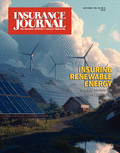State Farm is implementing a significant rate hike for Illinois homeowners, citing more frequent severe weather events and rising home replacement costs that are driving up the cost and frequency of claims.
The rate hike has drawn the ire of politicians including Illinois Gov. J.B. Pritzker, who called for state lawmakers to enact a legislative solution that prevents insurers from carrying out major rate increases.
State Farm is raising homeowners rates by an average of 27% and requiring customers to carry a minimum 1% wind/hail deductible in their home insurance policy. The rate increases go into effect July 15 for new business and August 15 for renewals.
 State Farm said in a rate filing with the Illinois Department of Insurance (IDOI) that the rate increase is primarily driven by expected catastrophe losses. According to State Farm, Illinois has had more hail damage than any state except Texas.
State Farm said in a rate filing with the Illinois Department of Insurance (IDOI) that the rate increase is primarily driven by expected catastrophe losses. According to State Farm, Illinois has had more hail damage than any state except Texas.
Illinois catastrophe losses have exceeded the year’s catastrophe provision in 13 of the last 15 years, State Farm said in the filing. The carrier said in a that in 2024 total costs amounted to $1.26 for every dollar in premium the company collected. The carrier pointed to rising inflation costs of labor and materials as another factor in raising rates.
“The cost of covering Illinois homeowners’ losses is exceeding the premiums we’re earning—an indication we need to adjust prices,” State Farm said.
IDOI said in a statement that is has requested information specific to State Farm’s rate filing, “which raised serious questions as to whether their specific rate increases were based solely on Illinois experience.”
“We requested further information from State Farm to provide greater transparency into their market practices, but they have repeatedly refused to provide the requested information,” IDOI said.
State Farm’s rate filing provoked criticism from Pritzker, who said State Farm is implementing an “unfair and arbitrary” rate hike on homeowners.
Pritzker said the increases are predicated on catastrophe loss numbers that are entirely inconsistent with the Illinois Department of Insurance’s own analysis. The governor claimed State Farm is shifting out-of-state costs onto the homeowners in Illinois.
“Hard-working Illinoisans should not be paying more to protect beach houses in Florida,” Pritzker said.
Pritzker asked lawmakers to enact a legislative solution during veto session that prevents insurance companies from taking advantage of consumers through “severe and unnecessary rate hikes like those proposed by State Farm.”
State Farm pushed back on the governor’s remarks, saying Illinois premiums are priced for the risk in the state—not for losses in other states, including wildfires, earthquakes, or hurricanes.
Last year the carrier earned $1.9 billion in direct premium and incurred $1.77 billion in direct losses in Illinois. The carrier’s 93.3% direct loss ratio far exceeded its nearest competitors. Bloomington, Illinois-based State Farm insures approximately one-third of all homeowners in the state.
Related: Is Industry Prepared? Hail, Convective Storms, Population Now Driving Billions in Losses
State Farm’s losses in Illinois reflect a trend of extreme severe wind and hail damage in the central U.S.
Severe storms don’t always produce national headlines like hurricanes and wildfires do, but their collective damage can be just as costly. For example, a convective storm outbreak this May caused an estimated billions of dollars of damages.
Meteorologists say warmer weather has contributed to more intense severe storms and have led to more storms developing outside of traditional tornado season.
State Farm’s decision to raise rates in Illinois by double digits reflect the state’s status as an increasingly risky place to write business.
State Farm has shown a propensity to implement major increase rates in states where it’s heavily exposed. Earlier this year State Farm was approved for a 17% homeowners rate increase in California following the January Los Angeles wildfires. After a judge approved the rate increase, State Farm upped its request to 30%.
Nationally, State Farm reported red ink for its homeowners and commercial multiple perils business in 2024, recording underwriting losses of $3.5 billion. State Farm’s property lines’ combined ratio was 110.1 in 2024, an improvement of five points from the prior year but far off its 2022 mark of 96.7.
Photo: Chicago suburb, AdobeStock
Topics Trends Pricing Trends Homeowners Illinois
Was this article valuable?
Here are more articles you may enjoy.



 Insured Losses From US Hurricanes Could Rise by 50% With Global Warming
Insured Losses From US Hurricanes Could Rise by 50% With Global Warming  Ken Griffin-Backed Florida Bill for Non-Competes Becomes Law
Ken Griffin-Backed Florida Bill for Non-Competes Becomes Law  Husband and Wife Sentenced for $20 Million Insurance Fraud Scheme
Husband and Wife Sentenced for $20 Million Insurance Fraud Scheme  US Tariffs Projected to Slow Global Economy and Insurance Premium Growth: Swiss Re
US Tariffs Projected to Slow Global Economy and Insurance Premium Growth: Swiss Re 

